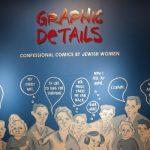

The gallery smelled of garlic and onions… , because the gallery’s air conditioning vents were situated above the Book Fair’s food court’s bbq grills. It gave the setting a homey feeling. Also present was Michael Kaminer, a dining critic for the NY Daily News, who wrote a story on this trend for The Forward in 2008.
Although Jewish artists and publishers have had an extensive role in the creation of comics, the focus has been on men and their superheroes. But women, particularly Jewish women, have birthed the autobiographical comic genre.
Diane Noomin was born in Brooklyn in 1947 and is the creator of DiDi Glitz. She was one of the early contributors to Wimmen’s Comics, Noomin created the first issue of Twisted Sisters Comics with Aline Kominsky Crumb in 1976, and has been the editor for Twisted Sisters. Arriving in San Francisco in 1970, she was instrumental in the founding of collectives of women cartoonists. Twisted Sisters was created after one editor complained that the comics of their collective had too many Jewish characters.
While Noomin trekked from Brooklyn to the Bay Area, Ariel Schrag did the reverse. She left Berkeley for Brooklyn. Schrag gained fame in high school when she self-published her first comic series, AWKWARD, depicting events from her freshman year of high school. Her stories focus on family life, going to concerts, drug use, romantic crushes, and coming out as lesbian. Schrag was also a writer for the Showtime series ‘The L Word’ Schrag said she began cartooning by trying to subvert or pervert the standard cartoon characters and superheroes.
Miriam Katin shared that Jewishness had zero influence on her art. It just so happens that her primary work concerned her family’s escape from the Holocaust. Born in Hungary, she survived WWII, and then emigrated to Israel, and then the United States. Her debut graphic novel, the 2006 memoir “We Are On Our Own,” was a portrait of how her family survived the Second World War. “Letting It Go” is her latest graphic memoir that shows Miriam struggling with her son’s move to Berlin, an event that triggers some long-held grudges.


A book on Jewish female cartoonists will be released in June 2014, titled “Graphic Details: Essays on Confessional Comics by Jewish Women” edited by by Sarah Lightman.






Thank you great post. php shell , php shell archive , php shell download , php shell indir , shell indir , web shell indir , shell download
Hey Just between, are some totally uncorelated websites blogs to ours, however, they are ultimate worth checking out.. Super! Turbo! Great this typography carry on as usual
Just between, are some totally uncorelated websites blogs to ours, however, they are ultimate worth checking out.. Super! Turbo! Great this typography carry on as usual
Definitely actually great website article which has got me considering. I never looked at this from your point of view.